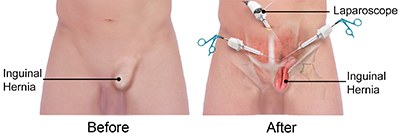Groin Hernia Surgery

What are Groin Hernias?
A groin hernia is the protrusion of an organ out of the abdominal cavity through a potential weakness or opening in the groin area. The most common organs found in groin herniae are fat, small intestine, and colon (incarceration of the latter 2 organs within the hernia can result in bowel obstruction).
Types of Groin Herniae
There are generally 2 common types of groin herniae:
- Inguinal Hernia: occurs in the inguinal canal which is a natural (oblique) opening within the abdominal wall. It carries arteries, veins, lymphatic vessels and vas deferens (spermatic duct) to and from the scrotum in men and it carries the round ligament to the labia in women. As weakness develops in the natural openings, they widen to allow organs in the abdominal cavity to enter (herniated) through to cause a bulge in the pubic area which becomes larger with coughing or straining. In men, they can become large enough to descend into the scrotum.
- Direct Inguinal Hernia: In this condition, the contents of the abdominal cavity push through a weakness or defect in the backwall of the inguinal canal to cause a bulge.
- Indirect Inguinal Hernia: In this condition, the contents of the abdominal cavity push through a weakened and widened opening of the inguinal canal.
- Femoral Hernia: The contents of the abdominal cavity push through a weakness in the femoral canal which is a natural opening containing artery, vein and lymphatic vessels to and from the leg. It presents as a bulge in the front upper thigh/groin region.
Symptoms of Groin Herniae
Common symptoms of a hernia include:
- Bulge in the groin/scrotum
- Aching pain (resolves if the bulge is able to be pushed back in)
- Dragging sensation
- Severe pain and redness in overlying skin (suggestive of a lack of blood flow to tightly entrapped hernia contents)
- Abdominal distension, nausea and vomiting (suggestive of loop of bowel that has tightly herniated through)
Causes of Groin Herniae
Unfortunately, the process of aging leads to progressive degeneration of connective tissue in all parts of the body including the abdominal wall which allows for existing natural openings to weaken with a resultant risk for inguinal and femoral herniae to form. This is further mediated by an increase in pressure inside the abdomen leading to a bulge or protrusion of an internal organ out of the abdomen.
Some of the factors that contribute to the development of a hernia through the chronic increase in pressure are:
- Persistent coughing
- Obesity
- Constipation
- Frequent heavy lifting.
Other Risk Factors for Groin Herniae
Besides aging, some of the more common risk factors for developing a groin hernia include:
- Sex: Men have a higher risk of developing inguinal hernias. Women are more likely to develop femoral hernias.
- Smoking: By altering connective tissue remodelling.
- Pregnancy: Weakening of abdominal musculature may occur during pregnancy through hormonal changes.
- Genetics: Although a clear inheritance pattern has not been established, you may be at a higher risk for developing a groin hernia if other members in your family have the condition.
Complications of Groin Hernia
An untreated groin hernia could result in:
- Worsening pain, swelling and redness in overlying skin
- Bowel obstruction
- Lack of blood supply to the organ that has protruded through the hernia (causing necrosis/gangrene to the hernia contents)
Diagnosis of Groin Herniae
Diagnosis of these conditions primarily involve in review of medical history and a thorough physical examination to identify the hernia, its likely contents and whether they can be reduced back into the abdominal cavity. An abdominal x-ray may be ordered to confirm or rule out an associated bowel obstruction. Occasionally, an ultrasound or CT scan may help determine whether there is a recurrence of a hernia after a previous surgical repair.
Types of Groin Hernia Surgery
Groin hernia repair may be performed as a laparoscopic (key-hole) procedure or as an open surgery.
- Laparoscopic Groin Hernia Surgery: This is a minimally invasive procedure performed through 3 keyhole incisions. After reducing the hernia, a synthetic mesh is placed inside the abdominal cavity whilst directly covering the hernial defect and then secured to the abdominal wall muscles. The mesh provides a scaffold for the incorporation and integration of scar tissue during the healing process. This procedure causes less scarring to the skin and potentially less pain/discomfort which may allow quicker return to routine activities.
- Open Groin Hernia Surgery: An incision is made in the groin over the hernia and the protruding tissue or organ is placed back into the abdomen. The weakened part of the abdominal wall is then plicated together and a mesh is fixated to the area to strengthen the repair by allowing migration and integration of scar tissue during the healing process. This may be a preferred surgical option in certain situations.
Postsurgical Care after Groin Hernia Surgery
After surgery, you may be encouraged to move about as soon as possible, but you will need to avoid heavy lifting or any activities that may strain the groin area. This is important as it will significantly reduce the risk of early hernia recurrence after your repair. It is also highly recommended that you should stop smoking before and after your surgery for the same reason. After 6 weeks, you should be able to return to your normal level of activity.
